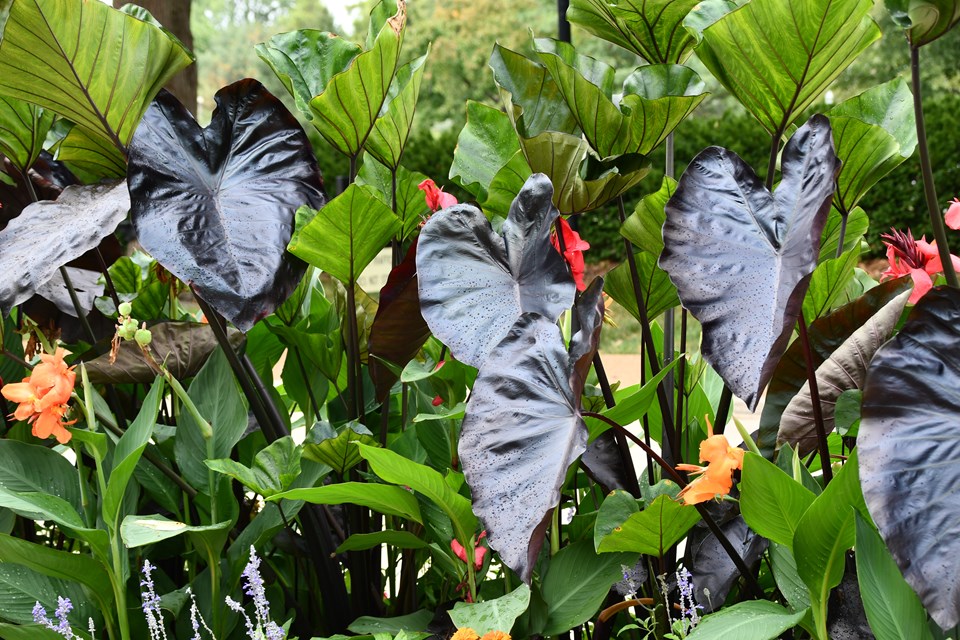Every year since 1998, the Missouri Botanical Garden has partnered with other regional horticultural institutions to select Plants of Merit. Plants of Merit are chosen for outstanding quality and dependable performance in Missouri, southern and central Illinois, and the Kansas City metro area. To qualify as a Plant of Merit, the plants must be easy to grow, noninvasive, ornamentally attractive, less susceptible to common problems like insects or diseases, and reasonably available to purchase.
Below are the 18 Plants of Merit that were chosen for 2019.
Alocasia ‘Sarian’ “elephant ear”
If you didn’t get a head start on summer landscaping this year, the elephant ear won’t mind. It thrives in warm weather and will do best in moist soil with part shade or filtered sun.
Colocasia esculenta ‘Black Coral’

This deep purple plant will retain its color in full sun, and its dark color adds some depth to a bright garden. Its common name, taro, comes from Hawaii. There it is grown commercially as a food crop–its tubers are used to make poi.
Impatiens BOUNCE SERIES

Impatiens is a versatile plant that can grow in beds, along borders, in containers, and even from hanging baskets, as they are often displayed in the Kemper Garden. The BOUNCE Series includes several different color options including red, white, and pink. Impatiens will do best with morning sun and afternoon shade.
Plectranthus ‘Uf0646’ REDHEAD
Plectranthus is a tropical evergreen tender perennial that is available in a wide variety of cultivars. The REDHEAD cultivar has a particularly high tolerance for heat and sun, but it will maintain its vibrant color in the shade too.
Melanthium virginicum

Also known as bunchflower, this native perennial does best in moist, rich, slightly acidic soils with full to partial sun. It takes a couple years to mature, but its tall, cream-colored flowers are worth the wait. It blooms in June and July, and it contains toxic alkaloids that keep munching pests away.
Lycopersicon esculentum ‘Rapunzel’

These will do best in full sun and soil of medium-moisture. The Rapunzel cultivar produces long, cascading stems with up to 40 red cherry tomatoes on each stem. The plants will do best when supported via staking or caging.
Physalis ixocarpa ‘Grande Rio Verde’

In terms of sun, water, and soil, the tomatillo can be treated much like its relative, the tomato. The Grande Rio Verde tomatillo has a higher resistance to disease and produces large fruits.
Solanum melongena ‘Aswad’

Eggplants are very cold sensitive and rarely recover from a cold snap, so it’s best to start them inside and transplant them to you garden once nighttime temperatures are consistently at 65 degrees or higher. The Aswad eggplant produces very large fruits with a squat, round shape. Plant in full sun and well-drained soil.
Codiaeum ‘Mammy’

These bright, colorful plants are commonly known as crotons. They can be grown outdoors or as houseplants and will look their best in bright light, well-drained soil, and a humid climate. The Mammy croton is characterized by curling, twisting, upright foliage.
Asclepias incarnata

The Asclepias incarnate, also known as butterfly weed or swamp milkweed, is a Missouri native found in swamps and wet meadows. This plant is a prime source of nectar for butterflies and is sure to bring them flocking to your garden. It will do best in a medium to wet soil in full sun.
Hylotelephium telephium ‘Cherry Truffle’

This plant is sometimes called “stonecrop” because of its ability to grow in rocky, infertile soil. “Live-forever” is another common name and refers to its foliage, which will often persist into wintertime. The Cherry Truffle variety has dark purple foliage and pink flowers in summertime. It will do best in a well-drained, gravelly soil and in full sun, but it can tolerate some shade.
Rudbeckia maxima

This plant, the large coneflower, is native to the American South. There it is found in wooded areas, moist prairies, pastures, and along roads and railroad tracks. The flowers bloom in summer and can be left in place after the petals fall—goldfinches will enjoy the seed that they provide. It does best in a moist but well-drained soil in full sun.
Hibiscus ‘Midnight Marvel’

The Midnight Marvel features long, violet-colored leaves that turn a brilliant orange in fall, contrasting beautifully with its carmine-red blooms. The hibiscus flower will bloom until first frost. It grows easily in moist soil and full sun.
Hydrangea arborescens ‘Hayes Starburst’

This plant needs part shade and medium-moist soil. A hydrangea shrub can grow quite tall, and its flowers cluster beautifully. The Hayes Starburst cultivar blooms from June into September and features rounded, dome-shaped flowerheads densely packed with starry, double white florets.
Physocarpus opulifolius ‘Mindia’ COPPERTINA

This shrub, more commonly known as ninebark, does well in dry to medium moisture in full sun or part shade. It features small pink or white, five-petaled flowers that appear in late spring and give way to drooping clusters of reddish fruit. Its bark peels in strips to reveal several layers of reddish to light brown inner bark, adding color to the landscape in wintertime. COPPERTINA features dramatic copper foliage that turns red by summer.
Quercus lyrata

The overcup oak tree is native to Missouri. Its name is derived from its acorns, which are almost completely encased by their knobby cups. It can grow to 40-60 feet tall.
Rhamnus caroliniana

Carolina buckthorn is noted for its bright, shiny green leaves and its edible fruit. It is native to much of the United States, including Missouri. It will grow easily in full sun to part shade with medium moisture soil.
Vigna Caracalla

This plant is commonly known as corkscrew vine or snail flower. It produces white-and-lilac, spirally twisted flowers from July to October. It requires a support structure to grow and performs best in full sun and moist but well-drained soil.

Leave a Reply